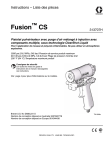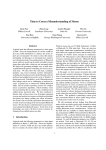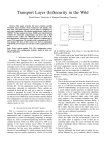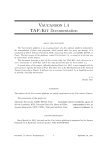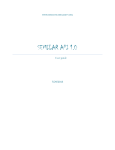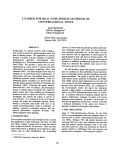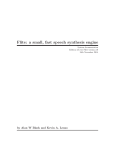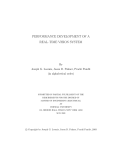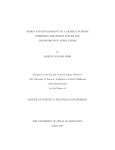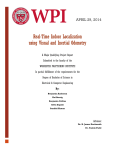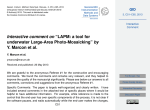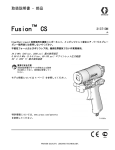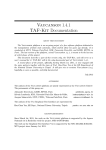Download iSpy: Automatic Reconstruction of Typed Input from Compromising
Transcript
iSpy: Automatic Reconstruction of Typed Input from
Compromising Reflections
Rahul Raguram, Andrew M. White, Dibenyendu Goswami,
Fabian Monrose and Jan-Michael Frahm
Department of Computer Science, University of North Carolina at Chapel Hill
Chapel Hill, North Carolina
{rraguram,amw,dgoswami,fabian,jmf}@cs.unc.edu
ABSTRACT
We investigate the implications of the ubiquity of personal
mobile devices and reveal new techniques for compromising
the privacy of users typing on virtual keyboards. Specifically, we show that so-called compromising reflections (in,
for example, a victim’s sunglasses) of a device’s screen are
sufficient to enable automated reconstruction, from video, of
text typed on a virtual keyboard. Despite our deliberate use
of low cost commodity video cameras, we are able to compensate for variables such as arbitrary camera and device
positioning and motion through the application of advanced
computer vision and machine learning techniques. Using
footage captured in realistic environments (e.g., on a bus),
we show that we are able to reconstruct fluent translations of
recorded data in almost all of the test cases, correcting users’
typing mistakes at the same time. We believe these results
highlight the importance of adjusting privacy expectations
in response to emerging technologies.
Categories and Subject Descriptors: K.4.1 [Computers
and Society]: Privacy
General Terms: Human Factors, Security
Figure 1: Some example threat scenarios that we investigated.
Video was recorded in both indoor and outdoor environments,
using various consumer video cameras. top: shoulder surfing,
bottom: reflection surfing, bottom right: key pop-out event.
Keywords: Compromising Emanations; Mobile Devices
1.
INTRODUCTION
The ability to obtain information without the owner’s
knowledge or consent is one which has been sought after
throughout human history, and which has been used to great
effect in arenas as diverse as war, politics, business and personal relationships. Accordingly, methods and techniques
for compromising – and protecting – communications and
data storage have been studied extensively. However, the
ubiquity of powerful personal computing devices has changed
how we communicate and store information, providing new
possibilities for the surreptitious observation of private messages and data. In particular, mobile phones have become
omnipresent in today’s society, and are used on a daily basis
by millions of us to send text messages and emails, check
Permission to make digital or hard copies of all or part of this work for
personal or classroom use is granted without fee provided that copies are
not made or distributed for profit or commercial advantage and that copies
bear this notice and the full citation on the first page. To copy otherwise, to
republish, to post on servers or to redistribute to lists, requires prior specific
permission and/or a fee.
CCS’11, October 17–21, 2011, Chicago, Illinois, USA.
Copyright 2011 ACM 978-1-4503-0948-6/11/10 ...$10.00.
bank balances, search the internet, and even make purchases. And while some of us may be concerned with – and
take steps to prevent – shoulder-surfing and direct observation of the text we input into these devices (see Figure 1),
how many of us spare a second glance for the person facing
us across the aisle on our morning bus ride?
In this work, we show that automated reconstruction of
text typed on a mobile device’s virtual keyboard is possible
via compromising reflections, e.g., those of the phone in the
user’s sunglasses. Such compromising reflections have been
exploited in the past for reconstructing text displayed on a
screen [2, 3], but these approaches require expensive, highpowered telescopic lenses. Our approach operates on video
recorded by inexpensive commodity cameras, such as those
found in modern smartphones. The low resolution of these
cameras makes visual analysis difficult, even for humans, and
severly limits the possibility of directly identifying on-screen
text. What makes this threat practical, however, is that
most modern touchscreen smartphones make use of a virtual
keyboard, where users tap keys on-screen. In the absence of
tactile feedback, visual confirmation is typically provided to
the user via a key pop-out effect, as illustrated on the bottom
right of Figure 1. Note that although the on-screen text is
essentially unreadable, the pop-out event provides a strong
visual cue to help identify the letter that was tapped. The
approach we take in this paper exploits this effect in order
to recover the text typed by the user.
Recent work has also explored the feasibility of reconstructing text typed on a full-sized physical keyboard based
on video from compromised web-cams [4]. In that scenario,
both the camera and keyboard are stable and in known positions relative to each other. In our case, both the phone and
the camera are free to move and can be positioned arbitrarily
with respect to each other, adding considerable difficulty to
any automated visual analysis. To further complicate matters, the user’s fingers often occlude portions of the visual
keyboard. We apply a variety of state-of-the-art techniques
to overcome these and other challenges.
As we show later, the approach we take offers much promise
in two real-world threat models, namely: (1) direct surveillance, wherein we assume the adversary is able to direct
the camera towards the screen of the mobile device (e.g.,
over the victim’s shoulder) and capture visual cues from the
virtual keyboard, and (2) indirect surveillance, wherein the
adversary takes advantage of indirect views of the virtual
keyboard obtained, for example, via “compromising reflections” of the phone in the victim’s sunglasses.
In both cases, we assume only inexpensive, commodity
video cameras, without any telescopic lenses or additional
high-end equipment. In addition, we make no limiting assumptions about the capture setup, the motion of the phone,
or the typing style of the user. Thus, the only input we
assume is a video sequence, either direct or indirect, of a
user typing on a virtual keyboard. We then use a number
of computer vision techniques to process the recorded video,
identifying, for each frame, potential keys that were pressed.
This visual detection, coupled with a language model, enables us to achieve surprisingly accurate sentence retrieval
results, even under challenging real-world scenarios.
Our ability to reconstruct text typed on virtual keyboards
from compromising reflections underscores the need to continually reevaluate our preconceptions of privacy – or the
lack thereof – in modern society. Even cryptography and
secure devices are of little use when, across the aisle, someone who appears to be reading email on their phone is in
fact surreptitiously recording every character we type.
2.
RELATED WORK
By now, it is well understood that electronic, electrooptical and electromechanical devices give off some form
of unintentional electromagnetic signals that can inadvertently leak sensitive information. The risks from these socalled “compromising emanations” were noted over half a
century ago, and led to the introduction of emission-security
tests standards to control leakage from digital electronics,
particularly when pertaining to classified information [23].
Although the nature of these emissions has changed with
evolving technology, side-channel attacks continue to surface [11, 16, 17, 21, 28, 31].
More recently, both visual emanations (e.g., from reflections on curved surfaces of close-by objects such as tea pots)
and acoustic emanations (e.g., from key presses on a keyboard or from the sounds made by dot-matrix printers) [1,
32] have been used to undermine the confidentiality of information displayed or entered into commodity devices. More
closely related is the work of Backes et al. [2, 3] on “compromising reflections” that presents eavesdropping techniques
for exploiting optical emanations using telescopic equipment.
There, the authors show that an adversary is able to successfully spy from distances as far as 30 meters away, and
in certain cases, can even read large text reflected in the
eyeball of the victim. In this work, we focus on a related,
but different, problem: namely, exploring the feasibility of
automatic generation of transcripts from low-resolution, indirect footage captured using inexpensive, and ubiquitous,
consumer electronics.
Also germane to this paper is the work of Balzarotti et al.
[4] that explores the idea of automatically reproducing text
from surveillance video – albeit from a camera mounted directly above a terminal – that captures a user’s typing as
she inputs data at the keyboard. Similar to Balzarotti et al.,
we apply the noisy channel model to help recover sequences
of words from streams of frames (with guessed labels); both
works also employ an n-gram language model. However, the
error model employed by Balzarotti et al. only accounts for
the deletion of identified characters and the substitution of
one character for another. In contrast, our model allows for
insertions, deletions, and substitutions, with substitutions
weighted according to the distance between the two characters on the keyboard. Moreover, unlike Balzarotti et al., our
frame parsing model handles spacing, allowing for the insertion and removal of spaces. An additional challenge in our
setting is the need to overcome significant instability in the
captured footage, as well as operate at a far lower resolution.
A more distantly related problem is that of extracting
captions in broadcast news in order to provide search metadata for digital archives. In these works, the low resolution
of characters within the video makes the problem of segmenting characters quite challenging, so much so that video
OCR typically does not perform well without significant text
enhancement [13]. As we show later, the problem is exacerbated in our context, where we operate on even lower resolutions and must simultaneously deal with instability in the
video (e.g., due to both camera and phone motion).
3.
OUR APPROACH
Our approach consists of a number of stages, each a difficult problem requiring the application of advanced computer
vision and machine learning techniques. At a high level, the
approach we take is to first detect and track the phone across
the frames of a video sequence. As we do so, stable and distinctive feature points are extracted from the phone area in
each frame, and subsequently used to compute stabilizing
image transformations. These transformations help eliminate the effects of camera and phone motion. The stabilized
video frames are also aligned to a reference image of the
phone (obtained, for instance, from the user manual of the
device of interest). In this aligned state, pop-out events for
each key are then localized to specific known regions of the
keyboard, and we train classifiers to recognize when a particular key has been pressed. The result is that for each frame,
we output a set of possible key pop-out events. To account
for missed and spurious detections, we subsequently use a
language model to impose additional constraints, thus refining the output of the computer vision modules. Finally, we
evaluate the effectiveness of our approach using established
metrics, designed to correlate well with human judgements,
for scoring machine translations. Next, we discuss each component of the overall design (given in Figure 2) in turn.
$!
#!
%!
2%!%"%DE%)
=CBLD%F)!"#$%M) PBQ%"%DE%)B$#L%M)
<@"A%BCC#DE%)ABF%G)
7HGD%)F%I%EJGD)
#DF)I"#EKBDL)
6@I;@I)I%XI)
7HGD%)MI#NBCBO#JGD)
'!
&!
UH%)V@BEK)N"GWD)!GXY)
T#DL@#L%)$GF%C)
=CBLD$%DI)IG)
"%!%"%DE%)B$#L%)
!"#$%&&'()*)+!),)&-../)
!"#$%&01()2)+!),).-34/)
!"#$%&53()6)+!),).-43/)
))))))))))))))))))))7)+!),).-8&/)
9"#$%&3&():)+;),).-''/)
!"#$%88&()<7=>?)+!),).-3&/)
!!!!!!!!!!!!!!!!!!!!!!!!"!
!!!!!!!!!!!!!!!!!!!!!!!!"!
!!!!!!!!!!!!!!!!!!!!!!!!"!
R%S);"%MM)F%I%EJGD)
Figure 2: Overview of our approach for typed input reconstruction from video.
3.1
Phone detection and tracking (Stage Ê)
Given a surveillance video, one of the most basic challenges we face is in determining the location of the phone in
the video. It is often the case that the phone occupies only a
small spatial region of the image, with the remaining portion
being unrelated background clutter (e.g., the phone in Figure 3 only occupies 1.8% of the total image area). Indeed,
the visual features on the background are invariably “distracting” for subsequent stages of our approach, since they
vastly outnumber the visual features on the phone itself. Determining the location of the phone in the video thus enables
us to focus specifically on the object of interest, eliminating
all irrelevant background information. Hence, our goal in
this stage is to compute (for every frame) an approximate
spatial region, or bounding box, that contains the phone.
The domains of object detection and object tracking have
received widespread attention in computer vision, due to
the ubiquitous nature of these problems [8, 15, 27, 29, 30].
In certain applications, such as frontal-view face detection,
modern techniques are capable of providing very accurate
results; indeed, most consumer point-and-shoot cameras today come equipped with built-in face detection technology.
The approach we take in this paper involves the formulation of the tracking problem as one of binary classification
[9, 15, 27]. The intuition is to train binary classifiers to
distinguish the appearance of the object being tracked from
that of the background. This training is either performed offline (using a dedicated training phase prior to running the
tracking algorithm), or online (where the appearance of the
object is learned during the tracking process). In the former case, tracking is typically very fast, since the classifiers
have been pre-trained beforehand. The latter, while slower,
is capable of adapting on-the-fly to changes in appearance
of the object. In our setting, the appearance of the object
being tracked can vary considerably, based on the model of
the phone, the relative orientation between the surveillance
cameras and the user, the ambient lighting conditions, occlusions, etc. Hence, to handle this appearance variability,
we elect to perform online training, learning the appearance
of the phone during the tracking process.
We base our phone tracker on the techniques proposed
in [8, 27], which describe an online AdaBoost [7] feature
selection algorithm for tracking. At a high level, boosting
is a classification scheme that works by combining a number of so-called weak learners into a more accurate ensemble
classifier. A weak learner may be thought of as a “rule of
thumb” that only has to perform slightly better than chance
– for example, in a binary classification problem, the error rate must be less than 50%. These can be as simple
as a threshold on a feature value. The intuition is that a
combination of these “weak” rules will often be much more
accurate than any individual rule. Given a set of training
images, where each image is labeled as positive (containing
the phone) or negative (not containing the phone), we obtain a training set χL = {hx1 , y1 i, ..., hx|χL | , y|χL | i}, where
xi is an m-dimensional feature representing the ith training image, and yi ∈ {+1, −1} is the corresponding label.
As suggested by Grabner et al. [8], we use three different
types of image features, concatenated to form the vectors
xi : Haar-like features [30], orientation histograms [20] and
local binary patterns [24].
Initially, each training example is given a uniform weight
p(xi ) = 1/|χL |. During the first round of training, we select
a weak learner that has the lowest weighted classification error, given χL and p(x), and add that learner to our ensemble.
Following this, the weights p(xi ) of the misclassified training examples are increased, while the weights of the correctly
classified samples are decreased. At each subsequent training iteration, we select a weak learner hi that does well on
the training examples that were hard for the previous weak
learners. The final ensemble classifier is then computed as
a linear combination of the selected weak learners, with the
weight of each learner being proportional to its accuracy.
While the above discussion describes an offline version
of boosting, the online variant assumes that one training
example is available (for instance, by drawing an approximate bounding box in the first video frame). This image
region becomes the positive training sample, and negative
examples are extracted from the surrounding background
regions. Given this data, multiple training iterations of the
online boosting algorithm are performed as above. In the
next frame, the ensemble classifier is evaluated at a number of possible image locations (e.g., in a search window
surrounding the object’s position in the first frame), with
each location being assigned a confidence value. The target
window is then shifted to the new location of the maxima,
Frame i
Positive
example
Frame i+1
Location of
new maxima
Search window
Negative examples
(a)
(b)
Figure 3: Phone tracking: (a) User-selected bounding box highlighting our positive example for training. (b) In the next frame,
the classifier is evaluated within a search window, and the position of the maximum response defines the phone’s new location.
and the classifier is updated using new positive and negative training examples so as to become discriminative to
variable object/background appearance. The operation of
the tracker is illustrated in Figure 3. Note that this is the
only stage of our overall approach that requires user input
– the user simply needs to draw a single rectangular bounding box around the phone area in the first video frame. All
subsequent stages of the algorithm are fully automatic. The
output of this module is the phone’s location in each frame,
allowing all further processing steps to focus on the phone.
3.2
Phone stabilization (Stage Ë)
The phone tracking stage provides, for every frame of
video, the coordinates of a bounding box that contains the
phone. Given these subimages, the next step is to compensate for the effects of phone and camera motion. As
discussed earlier, we do not impose any constraints on the
motion of either the camera or the user. While this enables
us to operate in a wide range of real-world threat scenarios,
it also results in a tremendous degree of variability in the
appearance of the phone within each detected subwindow.
Explicitly compensating for this motion would allow us to
effectively reduce one dimension of variability, resulting in a
more “stable” set of image frames to work with.
Before presenting the details of our stabilization algorithm, we introduce the notion of a homography [10]. In
computer vision parlance, a homography is a 2D projective
transformation that relates two images of the same planar
surface. In our setting, the phone represents a (mostly) rigid,
planar object, and we capture multiple images of this plane
from potentially different viewpoints. The images that we
capture – specifically, the portions of the image that contain
the phone – are related to each other via a 2D homography transformation. Note that in the case of reflections, the
image of the phone can be distorted due to the curvature
of the sunglasses. We do not explicitly model this in the
current system, but rather assume that the sunglasses are
approximately locally planar. Since the phone occupies only
a small area of the sunglasses, this approximation proves to
be sufficient in practice.
The 2D homography transformation has a number of important practical applications, one of which is image sta-
bilization. Given two views of a rigid planar object, along
with the homography H between them, the homography can
be used to warp one of the images in order to align it with
the other. In other words, if we were given access to H
with respect to the phone, then we could align the phone in
neighboring frames of a video sequence, thereby removing
the effects of phone and camera motion. In short, the basic
idea is to compute pairwise homographies between phones
in video frames, chaining them together to align all phones
in the frames to a common reference frame. The problem
now reduces to that of automatically determining the transformation H, given two neighboring video frames It and
It+1 . This is a well studied problem in computer vision,
and several algorithms have been proposed to automatically
estimate this transformation.
The approach we take involves two key steps. In our feature extraction and matching step, we extract stable,
repeatable and distinctive feature points in the two images,
with the intuition being that we would like to identify matching points in the captured images that correspond to the
same 3D point on the phone. For this we use the Scale Invariant Feature Transform, or SIFT [22]. Each SIFT feature
consists of a 2D image location, scale, orientation vector,
and a 128-dimensional feature descriptor which represents a
histogram of gradient orientations centered around the extracted feature. The main point is that a pair of features in
two images that correspond to the same point in 3D space
will have similar SIFT descriptors. The SIFT representation is powerful in practice, and its popularity stems from
their ability to tolerate a wide range of scale and illumination changes, as well some degree of viewpoint variation.
For this task, we use a fast in-house GPU implementation of
SIFT extraction and matching1 , capable of processing more
than 12 frames per second on a standard graphics card.
For our robust homography estimation step, we compute the homography H from N “true” feature matches between the two images using the normalized Direct Linear
Transformation (DLT) algorithm [10]. One limitation here,
however, is that doing so requires a minimum of N = 4
feature matches between the two images. Additionally, the
DLT algorithm is sensitive to outliers, or mismatched features. To combat this problem, we turn to the field of robust
statistics [12], where the problem of estimating quantities
from data that has been corrupted by noise and outliers has
been well studied. Perhaps the most popular of these robust estimators is Random Sample Consensus (RANSAC).
The popularity of RANSAC, particularly in computer vision – where noisy and outlying image measurements are
practically unavoidable – is primarily due to its ability to
tolerate a high level of data contamination. In our approach, we apply a fast, real-time variant of RANSAC, called
ARRSAC (Adaptive Real-Time Random Sample Consensus) [26], which simultaneously estimates the 2D homography, as well as returning the set of “true” feature correspondences. The resulting homography can then be used to
align the phone images together, thus nullifying the effects
of scene and camera motion.
The two steps outlined above are illustrated in Figure 4.
Figures 4(a)-(c) denote the process of SIFT feature extraction, matching, and robust homography estimation, respectively. Notice that the incorrect feature matches present
1
Available online: http://cs.unc.edu/~ccwu/siftgpu
12-3*.*/)4$5*4)6$78-9):$
0!"#$
(a)
(b)
0#$
0!$
0%$
0&$
0&'#$
(c)
!#"!"#$
!!"#$
!&"#$
!%"!$
!&'#"&$
()*+*,-.*/)$
Key “pop-out”
(d)
(e)
Figure 5: Iterative procedure to align video frames to the reference image (Iref ). To prevent long-term drift, the frames are
periodically reinitialized with respect to the reference image.
Figure 4: Automatic phone stabilization of two video frames.
in Figure 4(b) are “cleaned up” by ARRSAC, which selects
the set of true correspondences (shown in Figure 4(c)) out
of the potential correspondences (Figure 4(b)). These true
correspondences are then used to estimate the homography
between the two frames. Figure 4(d) shows the two frames
aligned with respect to each other, and Figure 4(e) represents the pixel-wise difference between the images after
alignment. In the difference image, dark pixels represent areas of low image difference, and lighter pixels represent areas
of high difference. Two points are pertinent: first, since the
difference image consists mainly of dark pixels, this is an
indication that the homography-based alignment has accurately aligned the images to each other; and second, observe
that the key pop-out event becomes apparent in the difference image. We will leverage these observations later.
3.3
Alignment to reference image (Stage Ì)
In the previous section, we showed how one could compensate for the effects of scene and camera motion by aligning the video frames using a robust homography estimation
procedure. However, while this results in a stabilized video,
one other aspect of appearance variation that remains unaccounted for is the relative positioning between the surveillance camera and the user. Note that we do not assume
that the camera has a clean, frontal view of the screen of
the device; rather, the surveillance camera can be oriented
arbitrarily with respect to the user. Given that our ultimate goal is the detection of pressed keys, we now reduce
the difficulty of our problem further by aligning the stabilized video to a reference phone image. This image can be
obtained easily, in a number of ways: for example, by taking a single frontal-view photograph of the phone or using a
photo from a reference manual. Alternatively, it would also
be possible to automatically infer the keyboard layout by
using character frequency analysis.
Given a reference image, the process of aligning the stabilized video to this reference image can be carried out in much
the same way as before; that is, by detecting features in the
reference image and the video frames, matching them, and
computing a robust homography estimate which can then be
used to warp all the video frames to the reference. In principle, we actually need to align only a single video frame to
the reference image, since the frames of the video sequence
have already been aligned to each other by pairwise homographies. More specifically, let Hj+1,j be the homography
that transforms video frame Ij+1 to frame Ij . Assuming
that I1 denotes the first video frame, the transformation between frame Ij+1 and frame I1 can be computed by chaining
together all previous pairwise transformations:
Hj+1,1 =
j
Y
Hk+1,k .
(1)
k=1
In theory, given a single transformation H1,ref , that aligns
frame I1 to the reference image Iref , then by extension, one
can align the entire video to the reference image. However,
one important issue arises in practice: error propagation.
Since the transformations are chained together, even a small
error in the estimation of homography Hj+1,j propagates to
all subsequent transformations. For a reasonably long video
sequence, this invariably leads to “drift”, where the alignment progressively deteriorates as more frames are aligned
to the reference image.
To combat this effect, we instead perform a more careful alignment process, depicted in Figure 5. We begin by
aligning frame I1 to the reference image Iref , via a robust
homography H1,ref , estimated using the techniques introduced in Section 3.2. We then align subsequent frames of
video by chaining together pairwise homography transformations – the difference being that every M frames (M = 50
in our experiments), we re-initialize our transformation with
respect to the reference image by recomputing the video-toreference image homography. We use the newly estimated
homography as the base transformation for the next window
of M frames.2 This process of inter-frame homography estimation is much more accurate, as well as far more efficient,
than performing alignment to the reference image. The reason is that the change in appearance of the phone between
two successive video frames is often very small, while the
change in appearance between the phone image in a random
video frame (captured under arbitrary pose and lighting conditions) and the reference image is much larger.
3.4
Key press detection (Stage Í)
Thus far, we have focused primarily on accounting for
sources of appearance variability: phone and camera motion and the spatial relationships between the user and the
2
In particular, we perform a non-linear minimization of the
estimation error [10] with respect to the reference image.
This is a common trick often used in practice to prevent
drift, and also helps prevent catastrophic failure in the event
of failed alignments.
surveillance system. The net effect of the operations performed thus far is to convert an arbitrary, free-form video
sequence into one that has been aligned to a stable, known
reference frame. There is a significant advantage to doing
so: by aligning the video to a known coordinate frame, we
know precisely which regions to inspect in order to find key
pop-out events. More specifically, once the video frames
have been aligned to the reference image, we can isolate the
key pop-out event of each key on the virtual keypad to a
specific spatial location (derived, for example, by overlaying
2D boxes on the reference image).
Although we have greatly simplified the problem, we are
still faced with challenges. For one, because we are operating
at a fairly low resolution, coupled with the fact that the
appearance of the keys is often “blurred out,” one can not
readily apply OCR techniques to recover the characters in
the isolated frames. Moreover, in several cases the pop-out
events are occluded. As an experiment, we applied a popular
open source OCR engine (tesseract-ocr) 3 to stabilized
frames from Stage Ì. The results were an abysmal failure –
no characters were correctly recognized.
Another complication is that the 2D boxes constituting
the keypad grid are overlapping – in other words, the key
pop-out events for neighbouring keys have a non-negligible
area of overlap. To address this, we do not make any final
decisions at this stage; rather, for each frame, we inspect
each key location independently and assign a score to each
key, which may be interpreted as the probability of the key
having been pressed in that frame. These scores, along with
their key labels, are then used in the final stage.
Training a key press classifier. The basic idea we use to
identify key press events is to exploit the fact that we have
a known, regular grid, and train a binary classifier for each
key on the keypad. The classifier for each key focuses on
a specific bounding box on the reference keypad, and aims
to distinguish between a key pop-out event and the “background”. We again make use of AdaBoost classifiers, introduced in Section 3.1, to perform this classification. In
addition, since we have explicitly compensated for multiple sources of appearance variation, we can, at this stage,
use an offline training procedure in order to have a classifier that is capable of rapid classification when processing
each frame of video. Since we are operating on small image
patches, and some illumination variation remains, we use
dense SIFT descriptors as the features for each patch (i.e.,
a SIFT descriptor is extracted for each pixel in the patch,
and concatenated to form a feature vector).
For each key on the keypad, we train a binary classifier,
by providing positive and negative examples of key popout events. This data is obtained by running a representative collection of training videos through Stages Ê-Ì, subsequently labeling each aligned frame with the key pressed
for the frame. For example, to detect the tapping of the
letter ‘C’, we extract a positive training patch from the 2D
box corresponding to that letter, and negative patches for
all other letters, at their respective locations. Each classifier
is then trained offline using the acquired samples.
On detecting keyboard layout mode: While the above discussion focuses primarily on the alphabet keys, the same
principles apply for special characters and numbers. On a
3
See http://code.google.com/p/tesseract-ocr/
smartphone, there is usually a special key that allows one
to toggle between alphabet and numeric/special character
mode. There are a couple of strategies one could adopt to
detect keyboard toggle: (a) train a classifier that inspects
the entire keyboard area to detect when the keyboard layout has been toggled, and then use the classifiers for the
appropriate keys in each layout or (b) at each key pop-out
location, run the classifiers for all keys that could potentially
pop out at that location, and select the classifier that yields
the highest score. In this work, we chose to pursue the latter
option, and have used that approach to successfully detect
numbers interspersed with alphabet characters.
Testing the classifier. Given a test video, and a pool of
trained key press classifiers, we run the test video through
Stages Ê-Ì. Then, for every frame of video, each classifier
inspects its respective image patch and outputs a classification score (the probability of that key having been pressed
in the frame). We reject detections that score less than 0.5.
Note that each classifier is run independently, and so there
could potentially be multiple keys that pass this threshold.
For each frame, we store all potential key labels and scores.
Once a key pops-out on the keypad, it typically stays in this
state for a fixed amount of time (e.g., about 0.25s on the
iPhone); this fact can be used to parse the detected sequence
of keys in order to identify tentative character breaks.
The observant reader would have noticed by now that
we have yet to discuss the issue of the “space” bar. On
many popular smartphones we examined (e.g., the iPhone
and NexusOne), there is no pop-out event for the space bar.
However, it is still possible to obtain a reasonable estimate
of the locations of the spaces in typed text, by performing
some straightforward post-hoc analysis. Given a sequence
of identified key press events, we determine the median time
interval t between successive key presses. If we now reinspect
our key press detections, we can label the frames lying between two widely separated4 key presses as potential space
events. Additionally, the visual classifier we use to determine
the space key event inspects a larger region of the keyboard,
with the intuition being that when users press the space, a
large portion of the keyboard is visible. This is by no means
foolproof: a few spaces may be missed, and false spaces may
be inserted when the user pauses between keystrokes. However, coupled with an image-based classifier, this analysis
can still provide useful information.
3.5
Parsing and Language Modeling (Stage Î)
Once we have identified key labels for each frame in a
video, along with potential character breaks and spaces, the
issue of identifying typed words still remains. We can view
this task in terms of the noisy channel problem, often encountered in speech recognition: given a sequence of observations (labeled frames), find the most likely sequence of intended words. This process is often referred to as maximumlikelihood decoding [14].
The noisy channel problem is often formulated in a Bayesian
framework. Let P (w|o) represent the probability of a word
sequence w given an observation sequence o. Then the decoding problem is that of finding ŵ = argmaxw P (w|o). Us4
A threshold of 1.5t appears to be effective in practice.
ing Bayes’ rule, this can be reformulated as
ŵ = argmax
w
P (o|w)P (w)
= argmax P (o|w)P (w)
P (o)
w
where P (o|w) represents the probability of observing a sequence o given that the sequence w was intended. The prior
P (w) represents the probability of observing word sequence
w in the language of interest. The denominator can be safely
omitted as it does not depend on w.
To solve the noisy channel decoding problem, speech recognition systems have long employed cascades of component
models, where each model represents one conceptual stage
in the task of transcribing speech. For instance, one such
cascade might consist of three models: 1) an acoustic model
which transforms an acoustic signal into component sounds,
2) a pronunciation model which converts sequences of sounds
to individual words, and 3) a language model, which governs
the combination of words into phrases and sentences. In this
case, P (w) represents the language model. The likelihood
P (o|w) can be further decomposed into sub-models, such as
the acoustic and pronunciation models, representing intermediate stages. Commonly, these sub-models are assumed
to be independent.
We draw on a large body of work on speech recognition
cascades that has proven to be very useful in our context.
However, in traditional speech recognition systems, the interaction between components often cannot be modeled explicitly, i.e., each step is performed independently. Pereira
and Riley [25] proposed an elegant solution to this problem,
representing each model and submodel as a weighted finitestate transducer (WFST), thereby allowing for decoding to
range over the entire cascade simulataneously. While a full
treatment of weighted finite-state transducers is beyond the
scope of this paper, we remind the reader that a finite-state
transducer is a finite-state machine with both an input and
an output tape and thus represents a mapping between sequences from two alphabets; applying weights to each arc
then allows for scoring each path through the transducer. A
finite-state acceptor can be viewed as the special case where
the input and output tapes are identical. Multiple finitestate automata can be combined in various ways: for example, a speech recognition cascade can be represented as the
composition of individual transducers for each stage. The
resulting cascade can then be composed with an acceptor
representing an input sequence, which transforms the decoding problem into that of finding the shortest path through
the resulting weighted finite-state transducer.
In what follows, we apply weighted finite-state transducers to solve the noisy channel decoding problem in a manner
similar to that of speech recognition cascades. That is, we
utilize a language model and define a number of component
models which, when combined, provide a probabilistic mapping from frame label sequences to word sequence. More
specifically, we first apply a frame parsing model, F, which
maps sequences of frame labels to character strings. We then
apply an edit distance model, E, which maps each character
string to a (weighted) set of similar character strings and
helps account for errors made by the typist, the recognition
algorithm, and the frame parser. Next, a dictionary model D
is applied, discarding those paths resulting in invalid words.
Finally, the language model L is applied, accounting for unlikely words and sequences of words in English.
Each component model is represented as a weighted finite-
state machine, and the application of each is performed by
composition. The resulting cascade WFST is then composed
with the input sequence, represented as acceptor I, resulting in a weighted transducer which maps from the input
sequence to word sequences. We then search this transducer for the shortest path, which corresponds to the most
likely sequence of words given the input sequence. We use
the OpenFST library5 to construct, combine, optimize and
search our model cascade.
B (delete)
B (match)
A (initial match)
start
A
B (initial match)
0
end of character
A (match)
B
end of character
space delete
A (delete)
Figure 6: Simplified frame parsing WFST, with only two characters, that maps a sequence of labeled frames to characters.
The frame parsing WFST (Figure 6) allows for character
break and space insertion as well as frame, break, and space
deletion and is parametrized by weights on each of these actions. Each path starts at the zero state, representing the
beginning of the frame label sequence. Upon encountering
a frame labeled with a character, a transition is made to
a character-dependent state (A or B, in this example) and
that character is output. Subsequent frames with the same
label are ignored freely, while those with a different character label are dropped with a penalty. In a typical path,
once a character break appears in the frame stream, the
transition back to the start state is made, from which the
string can end or a new character can begin. Thus an input stream ‘AA|BB’ would be output as ‘A|B’ in a typical
path. Other paths are possible, however, which insert or
drop characters breaks and spaces with certain penalties;
the same input would also generate, amongst other outputs,
‘A’ and ‘A|A|B’, albeit with a lower probability.
Our edit distance is based on the distance between keys
on the keyboard and is intended to correct any misclassifications by the recognition algorithm. It can also automatically
correct typing mistakes. The distance between two characters is straightforward. If both keys are in the same row,
then the distance is the number of keys between them. If
the keys are not in the same row, we calculate the distance
as though they were in the same row (with rows aligned on
the left-hand edge) and apply a multiplicative penalty for
each row the two keys are apart. This distance is then normalized to be between zero and one; we take the additive
inverse to obtain a probability estimate, which is weighted
with a parameter. Similarly, the insertion and deletion costs
are represented as probabilities and weighted with parameters, which allow for tuning the effects of the edit distance
on the overall cascade. For efficiency, we limit the number
of contiguous edits to two.
A simplified view of the edit distance WFST appears in
Figure 7. For the edit distance WFST, the most likely path
is a loop in the start state, in which case the output string is
identical to the input string. However, an edit (substitution,
insertion, or deletion) can be made, with a penalty, at any
position in a word, resulting in a path which transitions to
state 1; a second edit can then be made, transitioning to
state 2. From either of these states, a match – or the end of
5
www.openfst.org
match, end of word
1
match
start
0
edit operation
edit operation
match, end of word
2
Figure 7: Simplified edit distance WFST mapping sequences of
characters to similar sequences.
a word – is required to return to the zero state, which limits
to 2 the number of edits which can be made in a row.
The dictionary used is based on the medium-sized word
list from the Spell Checker Oriented Word Lists (SCOWL)6 ,
from which we removed roman numerals and the more obscure abbreviations and proper nouns. Finally, the language
model used is a unigram model, i.e., simple word frequencies,
trained on the well-known Brown corpus [6].
4.
EVALUATION
Recall that our primary goal is to explore the feasibility of
exploiting compromising reflections using low cost consumer
devices, and to impose very few conditions on the capture
environment. Towards this end, we experimented with capture devices ranging from a mid-range consumer grade device (a Canon VIXIA HG21 Camcorder, retailing for about
$1000) to low cost, hand-held devices (Kodak PlayTouch
and Sanyo VPC-CG20, costing $90 and $140, respectively).
The Kodak PlayTouch camera, for instance, has a form factor very similar to a smartphone, thus allowing for unobtrusive capture in real-world settings.
Our capture settings ranged from cameras mounted near
the ceiling of an indoor office environment to hand-held capture performed outdoors. For example, we recorded video
footage at a bus stop as well as on a moving bus. In the
indoor setup, the distance between the user and the camera
was approximately 14 feet, while the outdoor capture was
done at distances ranging from 4-7 feet (for instance, looking
over a person’s shoulder while sitting on a bus). At these
distances, the pixel dimensions of the phone in the captured
video ranged from about 49x75 to 114x149 (widthxheight).
In addition to low resolution, these datasets present numerous other challenges: unstable video, motion blur, reflections from other objects, etc. See http://cs.unc.edu/
~rraguram/ispy for some examples.
In total, we collected 18 videos (containing 39 sentences)
from ten different users typing on the iPhone. Our experimental setup covered a number of practical use-cases designed to elicit a variety of typing styles (and speeds), and
includes scenarios where subjects (a) typed short passages
of text from The Art of War and David Kahn’s The Codebreakers (b) simply typed whatever came to mind and (c)
typed responses to text messages (e.g., ‘What time shall we
meet?’) sent to the phone. In each case, subjects were
instructed to use the phone as they normally would. All
subjects routinely use smartphones.
4.1
Evaluating Output Quality
We now turn our attention to how we measure the quality
of our reconstructions. The problem we face here is similar to that found in both the automated speech recogni6
wordlist.sourceforge.net
tion and machine translation (MT) communities, which has
addressed many of the challenges associated with scoring
the output of such systems. While humans are the target
audience for MT systems (and therefore remain the ultimate arbiters of output quality), evaluations using human
judges pose several obstacles. For one, evaluations using experts can be prohibitively expensive; conversely, hiring nonexperts leads to issues with reliability and inconsistency.
More pragmatically, progressive development necessitates
frequent changes, evaluating the effectiveness of which requires rapid prototyping and testing.
Automated evaluation, on the other hand, allows system
designers to quickly test new ideas while providing a consistent basis for comparing multiple approaches. Ideally,
such automated evaluations would produce results similar to
those of human experts, who typically assess the adequacy,
or how well the appropriate meaning is conveyed, and fluency of a translation on a sentence-by-sentence basis. Similarly, state-of-the-art automated MT evaluation techniques
score a hypothesis (i.e., the machine translation) by comparing it with one or more reference (i.e., expert) translations.
The performance of these automated evaluation techniques
is judged according to how well the assigned scores correlate
with those assigned by experts.
Scoring our inferences. Before proceeding further, we note
that automated MT evaluation remains an area of active research, with entire conferences dedicated to the topic. Nevertheless, one widely adopted metric for producing scores at
the segment level is the Metric for Evaluation of Translation with Explicit ORdering [19]. METEOR accounts for
position-independent matching of words (i.e., to model adequacy) and differences in word order (i.e., to model fluency).
More specifically, the METEOR metric is the combination
of a weighted f -score and a fragmentation penalty. The f score is defined as the harmonic mean of unigram precision
p and recall r. In this context, precision is the ratio of the
number of (non-unique) words which occur in both the reference and the hypothesis to the total number of (non-unique)
words in the hypothesis. Recall is the ratio of the number of
words present in both hypothesis and reference translation
to the number of words in the reference.
Denkowski and Lavie [5] have extensively explored the
space of tunable parameters, and have identified different
sets of values that correlate well with human evaluations on
different tasks; we use the Human-Targeted Edit Rate parameter set with synonym matching disabled. As a guideline
for METEOR scores, Lavie [18] suggests that scores of 0.5
and higher indicate understandable hypotheses, while scores
of 0.7 and higher indicate good or fluent hypotheses.
4.2
Results
A boxplot of the METEOR scores for our reconstructions
of the sentences typed in our collected videos is provided
in Figure 8(a). Notice that in both the direct and indirect cases, more than 35% (8/23 and 6/16, respectively) of
our hypotheses achieve perfect scores, and none score below the 0.5 threshold representing “understandable” translations. We provide a few examples of our hypothesized transcripts in Table 1, where we also list the input as actually
typed by the user and the reference text used for scoring.
1
2
3
Typed:
Reference:
Hypothesis:
Typed:
Reference:
Hypothesis:
Typed:
Reference:
Hypothesis:
Sentence
to be prepared beforehand for any contingency is the greatest of virtues
to be prepared beforehand for any contingency is the greatest of virtues
to be prepared beforehand for any contingency the greatest of virtues
i freaked out by the possibilitu of someone else reafing this
i freaked out by the possibility of someone else reading this
i created out by the possibility of committee else reading the
i can levitate birds
i can levitate birds
i can hesitate birds
Scenario
Sunglasses
Canon
66x104
Direct, on-bus
Kodak
114x149
Sunglasses
Sanyo
92x107
Score
0.92
0.65
0.54
1.0
1.1
0.8
1.0
METEOR Score
METEOR Score
Table 1: Example hypotheses from our reconstruction process. Under ‘Scenario’ is given the details of the capture scenario for each
hypothesis, including camera type and phone image resolution. Note that Sentence 2 was captured on a bus.
0.6
0.4
0.2
0.0
correlation, as evidenced by a correlation coefficient (Pearsons’s r-value) of 0.07.
0.9
Isolated Word-Unit Matching. Lastly, there are a num-
0.8
ber of scenarios where an attacker might not wish to apply
the dictionary matching and language modeling stages: for
instance, when the text of interest is a secure password. Unfortunately, METEOR is not well-suited to evaluating accuracy in this scenario since we are interested in the ability
to reconstruct isolated word units, i.e., sequences of contiguous non-space characters, rather than phrases. For this
reason, we give instead precision and recall scores, based on
the number of word units which match between what was
actually typed and our reconstructed text. The results are
for the same sets of sentences as in the evaluation above,
but without the application of edit distance, dictionary, or
language models. In this analysis, we achieve precision and
recall, respectively, of 0.75 and 0.78 for direct surveillance
and 0.64 and 0.65 for indirect surveillance – in all cases, the
accuracy is high enough to recover more than half of any
typed passwords. In addition, our single-character precision
and recall scores are 94% and 98%, respectively, in the direct case, and 92% and 97% in the indirect case – certainly
accurate enough for password guessing, particularly given
that we have a reasonable prior distribution over characters
to drive password space exploration.
0.7
0.6
Direct (23)
Sunglass (16)
0.5
2 4 6 8 10 12 14 16 18
Image Area (thousands of pixels)
(a) METEOR scores (with (b) Plot of input area size
number of sentences).
against METEOR scores.
System-Level Analysis. It is also instructive to consider
evaluations at the level of entire corpora of documents, i.e.,
the system level. System-level analysis offers a different perspective and, in particular, smooths the dependency of the
scoring on the length of the sentence. For instance, even a
single mistake in a short sentence can lead to a relatively
low METEOR score, as in Table 1 (Sentence 3). Systemlevel analysis does not depend as strongly on the length of
invididual sentences and can therefore alleviate this issue to
some extent. The formulae are the same as at the sentencelevel, but instead, (i) the system-level precision is calculated
as the ratio of the sum of the counts of matched words over
all sentences to the total number of words over all hypothesis
sentences, and (ii) the fragmentation penalty is calculated
based on the total number of contiguous subsequences and
unigram matches over all sentences.
To better judge how well the system-level scores generalize, we also provide confidence intervals based on bootstrap
resampling, a common statistical technique for estimating
the distribution of a quantity, which consists of sampling
(with replacement) from the set used to derive a statistic and calculating a bootstrap statistic based on the new
sample. This process is repeated many times, resulting
in an empirical distribution over the statistic of interest.
For direct surveillance, we achieve a system-level METEOR
score of 0.89, with a bootstrapped 95% confidence interval
of [0.84, 0.93]. In the indirect surveillance case, we achieve
a lower, yet still respectable, system score of 0.77, with a
bootstrapped 95% confidence interval of [0.70, 0.86].
Impact of Input Resolution. To gain a deeper understanding of the influence of the various input resolutions (of the
phone’s screen) on our ability to reconstruct the typed text,
we plot the area (in pixels) of each input, against the ultimate METEOR score (Figure 8(b)). The figure shows no
5.
SUMMARY & LIMITATIONS
We explore the feasibility of automatically reconstructing
typed input in low resolution video, of, e.g., compromising
reflections, captured in realistic scenarios. While our results
are certainly disconcerting, it is prudent to note that there
are some important issues that remain open. Low pixel resolution of the phone image is one of the key problems we encountered. It can be caused by a variety of factors, including
camera aperture, wide angle lenses, motion blur, and large
standoff distance. All of these make the phone’s appearance
so blurry that no reliable features can be extracted, and so
our phone stabilization (Stage Ë) and alignment (Stage Ì)
methods fail in certain cases. We believe this could be addressed by using more sophisticated (and expensive) capture
techniques, as in [3], which addresses the allied problem of
capturing clear images from reflections.
Finally, there are potential defenses against the attacks
proposed in this work. One, in the indirect case, is the application of an anti-reflective coating, such as is common on
modern eyeglasses, on the reflection surface. Reducing the
brightness of the screen would also have a detrimental effect on any reconstruction. Finally, one might disable the
visual key press confirmation mechanism which we leverage
in this work. Obviously, our approach is not applicable to
situations where there is no visual key press confirmation.
Hence, devices that lack this effect – for instance, tablets,
or devices that use Swype – are not vulnerable to our attack. How to effectively handle these kinds of devices is an
interesting direction to explore. Incorporating temporal information through optical flow could potentially extend our
approach to cover these types of input. Lastly, as suggested
by Backes et al. [3], one could use secondary reflections in
the environment when direct line-of-sight to the target is
infeasible.
Nevertheless, the fact that we can achieve such high accuracy underscores the practicality of our attack, and aptly
demonstrates the threats posed by emerging technologies.
6.
ACKNOWLEDGMENTS
We thank the anonymous reviewers for their insightful
comments. We also thank Pierre Georgel for helpful suggestions in improving this work and Enrique Dunn, Jared
Heinly, Alex Keng, Megha Pandey, Anusha Sethuraman, Rohit Shah, Vishal Verma, and Enliang Zheng for assisting in
our data collection efforts. This work is supported in part
by NSF grant CNS-0852649.
References
[1] D. Asonov and R. Agrawal. Keyboard acoustic emanations.
In Proceedings of IEEE Symposium on Security and
Privacy, 2004.
[2] M. Backes, M. Dürmuth, and D. Unruh. Compromising
reflections-or-how to read LCD monitors around the corner.
In Proceedings of the IEEE Symposium on Security and
Privacy, 2008.
[3] M. Backes, T. Chen, M. Duermuth, H. Lensch, and
M. Welk. Tempest in a teapot: Compromising reflections
revisited. In Proceedings of the IEEE Symposium on
Security and Privacy, 2009.
[4] D. Balzarotti, M. Cova, and G. Vigna. ClearShot:
Eavesdropping on keyboard input from video. In
Proceedings of the IEEE Symposium on Security and
Privacy, 2008.
[5] M. Denkowski and A. Lavie. Choosing the right evaluation
for machine translation: an examination of annotator and
automatic metric performance on human judgment tasks.
In Proceedings of the AMTA, 2010.
[6] W. N. Francis and H. Kucera. Brown corpus manual.
Technical report, Dept. of Linguistics, Brown University,
1979.
[7] Y. Freund and R. E. Schapire. A decision-theoretic
generalization of on-line learning and an application to
boosting. In Proceedings of the 2nd European Conf. on
Computational Learning Theory, pages 23–37, 1995.
[11] H. J. Highland. Electromagnetic radiation revisited.
Computer Security, 5:85–93, June 1986.
[12] P. J. Huber. Robust Statistics. John Wiley & Sons, 1981.
[13] K. Jung, K. I. Kim, and A. K. Jain. Text information
extraction in images and video: a survey. Pattern
Recognition, 37(5):977 – 997, 2004.
[14] D. Jurafsky and J. H. Martin. Speech and Language
Processing: An Introduction to Natural Language
Processing, Computational Linguistics, and Speech
Recognition. Prentice Hall, 2008.
[15] Z. Kalal, K. Mikolajczyk, and J. Matas. Forward-backward
error: Automatic detection of tracking failures. Int.
Conference on Pattern Recognition, 2010.
[16] M. Kuhn. Electromagnetic eavesdropping risks of flat-panel
displays. In Privacy Enhancing Technologies, 2004.
[17] M. G. Kuhn. Optical time-domain eavesdropping risks of
CRT displays. In Proceedings of the IEEE Symposium on
Security and Privacy, 2002.
[18] A. Lavie. Evaluating the output of machine translation
systems. AMTA Tutorial, 2010.
[19] A. Lavie and M. J. Denkowski. The METEOR metric for
automatic evaluation of machine translation. Machine
Translation, 23:105–115, September 2009.
[20] K. Levi and Y. Weiss. Learning object detection from a
small number of examples: the importance of good features.
In Computer Vision and Pattern Recognition, 2004.
[21] J. Loughry and D. A. Umphress. Information leakage from
optical emanations. ACM TISSEC, 5, August 2002.
[22] D. Lowe. Distinctive image features from scale-invariant
keypoints. Int. Journal of Computer Vision, 60(2), 2004.
[23] NSA. TEMPEST: A signal problem. Cryptologic Spectrum,
2(3), 1972.
[24] T. Ojala, M. Pietikäinen, and T. Mäenpää. Multiresolution
gray-scale and rotation invariant texture classification with
local binary patterns. IEEE Trans. Pattern Anal. Machine
Intelligence, 24:971–987, July 2002.
[25] F. C. N. Pereira and M. Riley. Speech recognition by
composition of weighted finite automata. The Computing
Research Repository, cmp-lg/9603001, 1996.
[26] R. Raguram, J.-M. Frahm, and M. Pollefeys. A
comparative analysis of RANSAC techniques leading to
adaptive real-time random sample consensus. In European
Conference on Computer Vision, pages II: 500–513, 2008.
[27] S. Stalder, H. Grabner, and L. V. Gool. Beyond
semi-supervised tracking: Tracking should be as simple as
detection, but not simpler than recognition. Workshop on
On-line Learning for Computer Vision, pages 1409–1416,
Sept. 2009.
[28] W. van Eck. Electromagnetic radiation from video display
units: an eavesdropping risk? Computer Security, 4:
269–286, December 1985.
[29] P. A. Viola and M. J. Jones. Rapid object detection using a
boosted cascade of simple features. In Computer Vision
and Pattern Recognition, 2001.
[8] H. Grabner, M. Grabner, and H. Bischof. Real-time
tracking via on-line boosting. In British Machine Vision
Conference, volume 1, pages 47–56, 2006.
[30] P. A. Viola and M. J. Jones. Robust real-time face
detection. Int. Journal of Computer Vision, 57(2), 2004.
[9] H. Grabner, C. Leistner, and H. Bischof. Semi-supervised
on-line boosting for robust tracking. European Conf. on
Computer Vision, pages 234–247, 2008.
[31] M. Vuagnoux and S. Pasini. Compromising electromagnetic
emanations of wired and wireless keyboards. In Proceedings
of the 18th USENIX Security Symposium, 2009.
[10] R. I. Hartley and A. Zisserman. Multiple View Geometry
in Computer Vision. Cambridge University Press, 2000.
[32] L. Zhuang, F. Zhou, and J. D. Tygar. Keyboard acoustic
emanations revisited. ACM TISSEC, 13, November 2009.













